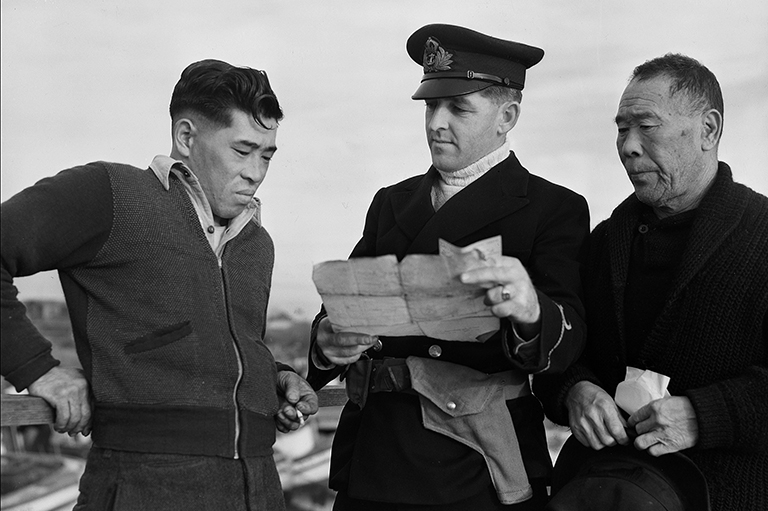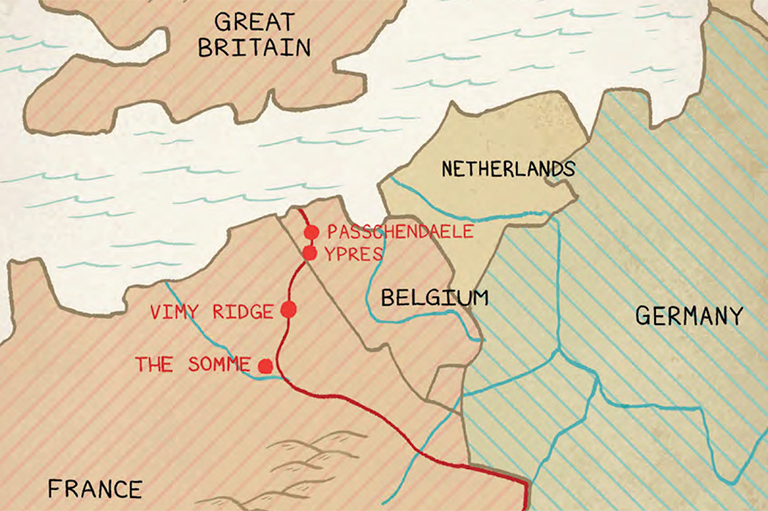Turning Points: Crises in French-English Relations
Grade Levels: 9/10, 11/12
Subject Area: Social Studies, History, Geography, ELA, Civics
Lesson Overview
This lesson will aid students in understanding the historical conflict and crises between the French and English in Canada between the 1830s and 1891. By choosing one or more of the “Turning Points”, students will research, role-play, analyze and interpret the political clashes before and after Confederation.
Time Required
5 classes
Historical Thinking Concept(s)
This lesson plan uses all six historical thinking concepts. This includes: establish historical significance, use primary source evidence, identify continuity and change, analyze cause and consequence, take historical perspectives, and understand the ethical dimension of historical interpretations.
Learning Outcomes
Student will:
- Study and investigate a series of major crises and turning points in Québec-Canada relations between the 1830s and 1891.
- Identify and explain the actual viewpoints and arguments used by the key political figures.
- Develop the ability to analyze primary documents, to write historically accurate speeches, and to define the viewpoints in a press conference setting.
- Develop a real sense of history and a passion for the subject.
- Produce a short analysis (500 words) explaining the crisis in its proper context.
Background Information
The years from 1837 to 1885 produced a series of crises in the relations between French and English-speaking Canadians that profoundly affected the relationship between Québec and the rest of Canada. The social and political conflict of the 1830s found its clearest expression in the Rebellions of 1837–38 led by Louis Joseph Papineau and the Patriotes.
Following the rising, Lord Durham issued his famous report attributing the causes of the existence of “two nations warring in the bosom of a single state.” The Union of 1840 united the two Canadas and gave rise to a form of bicultural compact symbolized by the Baldwin-Lafontaine alliance. A movement for a wider union culminated in the dramatic Québec Conference where the Confederation agreement took its final shape. Just twenty years after Confederation, Louis Riel led a North West Rebellion and the political crises that followed threatened to tear the Dominion apart. Confederation survived the series of events and somehow emerged stronger than before.
The Lesson Activity
The Simulation Exercise
A historical simulation exercise involves students in re-enacting past events using authentic documents and the skills of historical role-playing. In this exercise, students will be both introduced to, and immersed in, the major political “crises” and turning points in French-English relations from the Patriotes Revolt of 1837-8 to the national crises over the fate of Louis Riel.
All students will be expected to research and present (or role-play) ONE major historical character over the course of the simulation exercise. When not engaged in lead roles, all students are expected to cover the events as press reporters assigned by actual British North American newspapers of the time. As reporters, they must keep a record of the public debates and file periodic press stories.
Materials/Resources
The “Turning Points” 1837–1885
Dateline 1837: The Patriotes Revolt in Lower Canada
Scenario: A street rally of the Patriotes called by Louis Joseph Papineau to protest the misdeeds of the “Château Clique” and demand far-reaching political changes. Sir John Colborne, the Commander of British forces in the Canadas, rejects the Patriotes demands and it leads to a full public debate. The voices of rebellion are a precursor to armed conflict.
Time: Eve of Rebellion, 1837
Locations: St. Eustuche and Montréal
Leading Historical Roles:
- Louis-Joseph Papineau, Parti Patriote
- Sir John Colborne, Commander of British Forces
- William Lyon Mackenzie, Radical Reformer, Toronto
- Etienne Parent, Editor, Le Canadien, Montréal
- Chevalier DeLorimier, Patriote, Montréal notary
- Susanna Moodie, author and settler, Cobourg, Upper Canada
Dateline 1839: Lord Durham’s Report and the Reaction in Lower Canada
Scenario: Lord Durham (“Radical Jack”), appears in Montréal with British colonial officials to present his famous report focusing on his analysis of the Lower Canadian troubles and his political reform solutions. Lord Durham’s critics respond with a press conference to denounce his report and its proposals.
Time: January 1839
Location: Montréal
Leading Historical Roles:
- John George Lambton (Lord Durham), Lord High Commissioner, 1837–39
- Arthur Buller, Chief Secretary to Lord Durham
- Charles Poulett Thompson (Lord Sydenham), Governor-General, 1839–41
- Louis Hippolyte Lafontaine, Reformer, Lower Canada
- Editor of L'Avenir, Rouge newspaper, 1839
Dateline 1848: The Triumph of the Bicultural Compact—the Baldwin-Lafontaine Alliance
Scenario: The political reform alliance of Robert Baldwin (Upper Canada) and Louis H. Lafontaine (Lower Canada) wins the Canadian elections of December 1847 and succeeds in gaining both the responsible government and representation on the Executive Council. Leading political figures respond to the Baldwin-Lafontaine alliance and its program, including the Rebellion Losses Bill and amnesty for the Patriotes of 1837-38.
Time: March 1848 and 1849
Location: Parliament buildings, Montréal
Leading Historical Roles:
- Louis Hippolyte Lafontaine, Reformer, Canada East
- Robert Baldwin, Reformer, Canada West
- Etienne Parent, Editor, Le Canadien
- Louis Joseph Papineau, former Patriote
- Lord Elgin, Governor-General, 1847–54
Dateline 1864: The Quebec Conference and the Fate of French Canadians
Scenario: A re-enactment of the key debates at the crucial Québec Conference leading directly to Canadian Confederation. The leading Canadian politicians present the case for British North American Union and its advantages for Frenchspeaking Lower Canada. The Parti Rouge, led by Antoine-Aimé Dorion, call a press conference to reject the proposals and release its manifesto.
Time: October and November 1864.
Location: Québec City and Hochelega (Dorion’s Montréal Riding)
Leading Historical Roles:
- John A. Macdonald, Liberal/Conservative, Kingston
- Georges Etienne Cartier, Parti Bleu, Montréal
- Antoine-Aimé Dorion, Parti Rouge, Hochelaga
- E.P. Tache, Parti Bleu, Chair of Conference
- George Brown, Reform-Grit, Toronto
- Mercy Coles, Daughter of former PEI Premier, Charlottetown, PEI
Dateline 1885: The Trial of Louis Riel and Its Consequences
Scenario: A re-enactment of the trial of Louis “David” Riel for treason in Regina, SK, July 28 to August 1, 1885. Riel represents his own defence and witnesses are called to give evidence for and against his execution by hanging. Prime Minister John A. Macdonald announces his position on Riel’s execution and Honoré Mercier, Leader of Parti National, expresses his grief over the hanging of Riel.
Time: August 1, 1885 and November 1885
Locations: Court room, Regina; Parliament Hill, Ottawa; and champ de Mars, Montréal.
Leading Historical Roles:
- Louis David Riel, Leader of the Métis Nation
- John A. Macdonald, Prime Minister
- Honoré Mercier, Leader of the Parti National
- Big Bear, Chief of Cree People, Saskatchewan
- Marie Anne Gaboury, Mother of Louis Riel (Ghost)
Press Galary Roles
Recognized newspapers in British North America
Lower Canada/Canada East/Québec:
- The Gazette, Conservative, Montréal
- La Minerve, Bleu, Montréal
- Le Pays, Rouge, Montréal
- Le Canadien, Moderate Independent, Québec
- The Mercury, Tory-Mercantile, Québec
- La Vérité, Patriote and Nationaliste, Québec
- Vindicator, Irish Radical, Montréal (1834-37; closed in 1847)
Upper Canada/Canada West/Ontario
- The Globe, Reform, Toronto
- Intelligencer, Conservative, Belleville
- Evening News, Orange/Conservative, Toronto
- The Citizen, Conservative, Ottawa
- Colonial Advocate, Radical Reform, Toronto. (The Constitution, after 1836)
- Chronicle/Whig Standard, Moderate Tory, Kingston (1819–47 and 1847–)
- Grip, Liberal/Grit, Toronto (1874–85)
Other Provinces and Territories
- The Gleaner, Anti-Confederate, Chatham and Fredericton, NB
- Morning Chronicle, Liberal, Halifax, NS
- The Herald, Anti-French, Battleford, SK
- The Reporter, Pro-Confederate, Fredericton, NB
- British Colonist, Expansionist, Victoria, BC
Themes associated with this article
Advertisement




